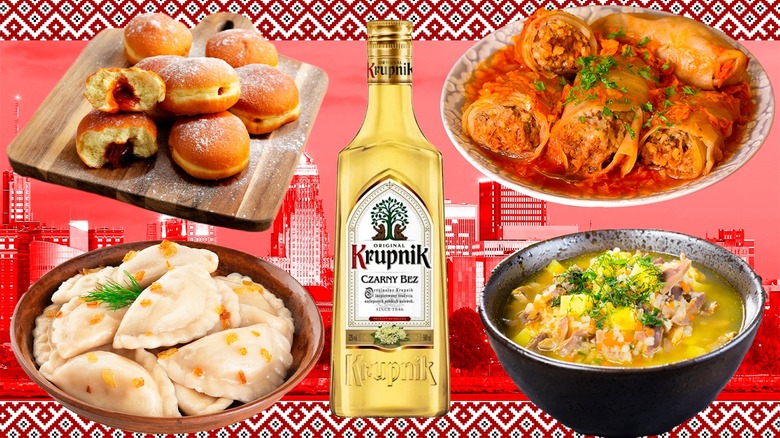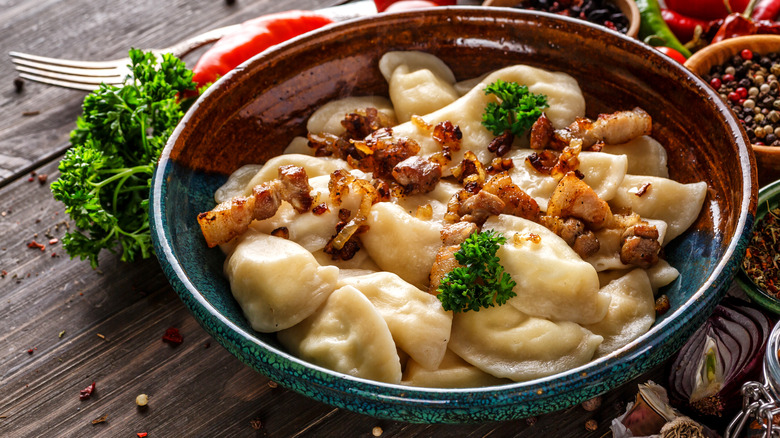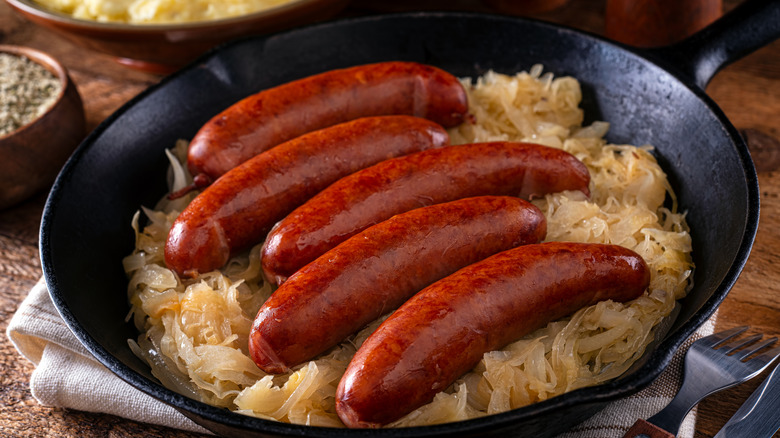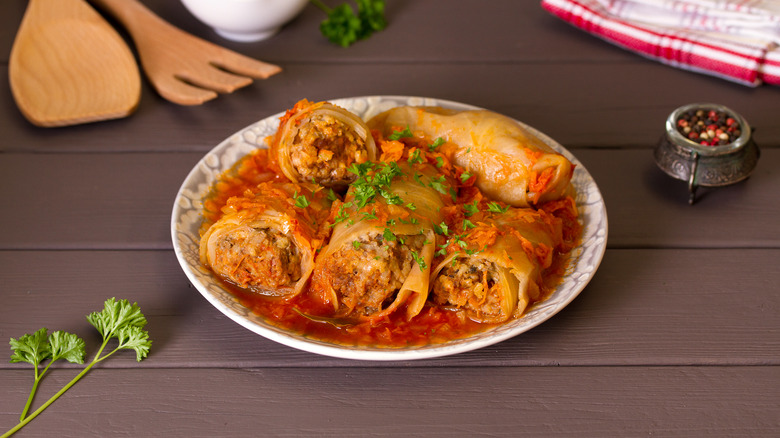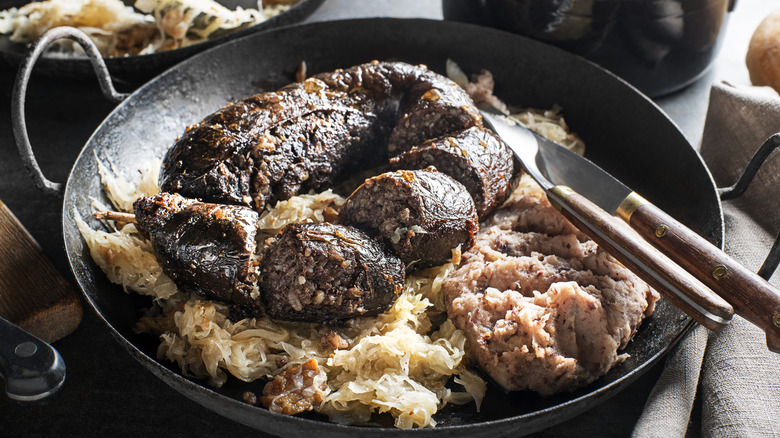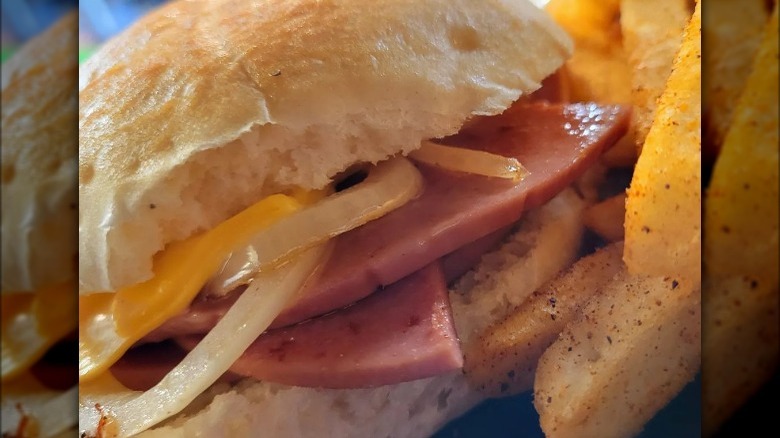13 Traditional Dyngus Day Foods And Drinks In Buffalo, NY
You might not give the day after Easter a second thought, or maybe you refer to it as Easter Monday. But in Buffalo, New York, Dyngus Day is marked by a massive Polish-American celebration, with events held all around the city and a parade that runs through a historic Polish neighborhood. Dyngus Day traditions include people dousing each other with water (a reference to baptism) and carrying of pussy willows in observance of spring.
The roots of Dyngus Day can be traced to the 10th century, when Poland adopted Christianity as the state religion and Prince Mieszko I baptized his court in celebration. Polish immigrants started coming to Buffalo en masse during the late 19th century, bringing the observance of Dyngus Day and other traditions with them, but public celebrations weren't held until the 1960s. The city-wide celebration of Dyngus Day didn't take off until 2007, when the first Dyngus Day Buffalo Parade was held.
Since then, the size of the parade and polka-soundtracked parties have only grown bigger. Dyngus Day is also the biggest day of the year in Buffalo for Polish food and drink. Even though it's held on a Monday, it's common for people to eat and drink from dawn until dusk, and beyond. Let's take a look at what they're usually eating and drinking.
Pierogi
Having been around for hundreds of years, pierogi have been stuffed with all kinds of things, from wild mushrooms to salmon to sweet fruit filling. In Poland, you can still find pierogi stuffed with a wide range of sweet and savory fillings. In Buffalo, pierogi have traditionally come in three different varieties: farmer's cheese, sauerkraut, or mashed potatoes laced with caramelized onions. More recently, people have begun to take a more irreverent approach to pierogi, and it's become more common to find them with modern fillings like chicken wing dip and bacon jalapeño cheddar.
There is some technique involved in making pierogi. If you want to make these stuffed dumplings at home, there are some big pierogi-making mistakes you'll want to avoid. One of the biggest mistakes you can make is trapping air inside when sealing them. This will cause your pierogi to burst open when boiled. It's also important to avoid boiling your pierogi too much. Overboiling also causes them to burst open, releasing their precious filling.
Kielbasa
While there are many different varieties of this popular Polish sausage, the two you'll most often see in Buffalo are referred to as "smoked" and "fresh" kielbasa. The smoked variety is reddish brown, and it has both a peppery taste and a mild smokiness. It's often sautéed and served alongside similarly pan-fried perogies. The fresh variety of kielbasa is white in appearance and strongly flavored with marjoram, giving it a robust, herbal flavor profile. While this kind of kielbasa can also be sautéed, it's also commonly used in soups like white borscht. When you are buying kielbasa, it's best to get it from a butcher shop or deli that makes it in-house. If you can't get your hands on house-made kielbasa, look for packaged kielbasa with minimal additives.
Of course, there's a trendier method for cooking kielbasa, and it's been championed by celebrity chef Ina Garten. Inspired by a specific way to roast a potato, Hasselback kielbasa involves making width-wise slices a little more than halfway through the sausage, all along its length. Garten takes the technique a bit further by glazing the sausage with a honey mustard dressing before roasting. This adds more flavor to the kielbasa and gives it a caramelized glaze.
Gołąbki
One of many types of European cabbage rolls, gołąbki are a great way to stretch a small amount of meat into an entire dish. Typically, large cabbage leaves are filled with a mixture of ground pork, ground beef, rice, and seasonings, before being rolled up into a tight tube shape. The Polish word "gołąbki" means "pigeon," possibly a term of affection for these cute little savory packages. Although rice is a standard ingredient in gołąbki today, earlier versions of this dish likely used buckwheat, which is native to central Europe. Also, modern versions are covered in a rich tomato sauce before being baked in an oven, earlier versions omitted the tomato sauce and were served alongside a sauce made of sour cream and mushrooms. Gołąbki are commonly served with applesauce or rye bread and butter.
Gołąbki are a menu staple at Polish restaurants around Buffalo all year long. On Dyngus Day, they make an appearance at event halls throwing Dyngus Day bashes, often served by smiling volunteers out of tinfoil steam trays. It may not be the fanciest dinner service, but after the parade and a bit of afternoon partying, you don't really care.
Lazy pierogi
Many countries in Eastern Europe have their version of a noodle casserole dish that includes cabbage or sauerkraut in a buttery sauce. Slovaks call their version hałuski, but the Polish-American community around Buffalo commonly refers to their version as lazy pierogi. The colloquial name for this dish likely came about because it's typically made with mostly packaged ingredients: canned sauerkraut, canned mushrooms, canned cream of mushroom soup, and packaged spiral pasta noodles. Clearly, it's a product of mid-century America, when convenience trumped freshness. This brings up all kinds of debates about what's truly authentic, and what isn't.
Putting those debates aside, you can use our savory hałuski recipe as a guide and make a much fresher version of lazy pierogi. It includes fresh mushrooms instead of canned and forgoes the canned mushroom soup in favor of butter. Because using fresh cabbage would take this in more of a Slovakian direction, we recommend using pickled cabbage or sauerkraut — ideally homemade instead of the canned stuff from your local supermarket.
Kiszka
A sausage made with pork blood and organ meat might not seem too appealing. However, blood sausage is common in French fine dining and other refined cuisines around the world. Kiszka likely came to Poland from Western Europe around the 17th century, and it became popular amongst the country's aristocracy. Polish peasants living at the time were much more likely to see dumplings, potatoes, and cabbage on their dinner table than they were to see blood sausage. For working-class people, the slaughtering of a pig wasn't a common event. But when it did happen, these folks made use of every bit of the animal, making kiszka on the dinner table a special occasion.
Although it isn't as popular as kielbasa, kiszka is sold in Polish restaurants and delis around Buffalo all year long. On Dyngus Day, this traditional blood sausage reaches peak popularity thanks to the iconic polka "Who Stole the Kiszka?" In a typical preparation, the sausage is removed from its casing and pan-fried in butter along with some onions. It's often eaten with rye bread or potatoes.
Czarnina
Made with duck's blood, czarnina (also spelled "czernina") might seem like something peasants ate back in the day, but the soup has a storied place in Polish culture. In "Sir Thaddeus" — the national epic poem of Poland — czarnina plays a key role in the plot. The soup is named after the Polish word for black: "czarny." In "Sir Thaddeus," an arrogant suitor of a noble daughter is served "the black soup" at dinner as a symbol of rejection. A recipe for czarnina also appears in a 1682 cookbook from Stanisław Czerniecki, chef for the Lubomirskis, a Polish noble family.
Whether you're looking to reject a suitor or gird your loins for Dyngus Day, czarnina is a great example of the sweet-sour flavor profile that's so popular in Polish cuisine. In Buffalo, the soup has mostly been enjoyed by older generations, but it's actually getting a second look these days in the form of mock czarnina— which is made without the duck's blood but still packs the essential flavor. It's an elegant solution for the people without access to fresh blood, and for those of us without vampiric tendencies.
Fried bologna sandwich
The fried bologna sandwich may be a Southern classic, but the Buffalo version is all its own thing, and even more decadent. The Southern version is made with two slices of white bread, a slice or two of American cheese, mayonnaise, mustard, and shredded lettuce. The Buffalo version starts with thick-sliced bologna "steaks" that can be as thick as your pinky finger. As the bologna is finished being pan-fried, it's topped with American or provolone cheese. Next, sliced onions and occasionally green peppers that have been grilled alongside the bologna are placed on top of the melting cheese. The entire stack is then placed into a kaiser roll or a hard roll. Many people top it with horseradish mustard, which is a popular local condiment.
The result is a rich, salty, melty sandwich that's punctuated by the zing of the mustard and the crunch of the grilled vegetables. On Dyngus Day, when the beer is flowing, songs are being sung, and the people are dancing, a hearty fried bologna sandwich provides both energy and the essential soaking up of alcohol. Needless to say, it also pairs well with a beer.
White borscht
Strongly associated with a hearty Polish soup called żurek, white borscht is a creamy, peppery, and sour soup studded with slices of kielbasa and hard-boiled egg. Traditional recipes call for a sourdough-like starter to be used as both a flavoring and thickening agent. However, in Polish-American communities like Buffalo, it's more common for home cooks to add a few splashes of vinegar for tanginess, and sour cream for thickening.
The preparation of this soup doesn't start in the kitchen. Traditionally, the ingredients for white borscht are purchased, placed in a basket, and brought to church to be blessed by a priest on the day before Easter. The soup is then made on Easter Sunday. Rather than being based on a more typical stock, white borscht is based on a stock made by boiling kielbasa in water. After the kielbasa has cooked through, the sausage is removed, the other ingredients are added, and adjustments are made according to taste.
Polish-style lager
Slightly malt-forward with subtle hop bitterness, Polish-style lagers are crisp and refreshing. On Dyngus Day, Buffalonians love authentic imported lagers from Tyskie, Zyweic, and Okocim. But recently, many local craft breweries have been putting out their own annual takes on Polish-style lager for Dyngus Day. One of the more popular is Polonia Pils from Flying Bison Brewing, which features soft malt notes and a spiciness from the inclusion of Saaz hops.
Buffalo Brewing Company is another local brewery, and it makes a unique Polish style of beer called Grodziskie for Dyngus Day. Grodziskie has a signature flavor that comes from the use of smoked wheat malt and Polish hops. After reading that, you might expect the flavor of Grodziskie to be dominated by smokiness, but a well-made version only has a light smokiness. This beer is also lagered for at least a month, and the resulting high level of carbonation has led to Grodziskie being dubbed "Polish champagne."
Krupnik
Spiced and syrupy sweet, krupnik is a liqueur from Poland that you would hardly call a refined spirit. In Buffalo, it was largely relegated to bottom-shelf status at Polish-heritage social halls and restaurants. That is until around 2007, when annual Dyngus Day revelers craving all things Polish put krupnik on a pedestal. Today, it has a massive cult following in the city. Although people will do shots of krupnik year-round, it has become one of the unofficial drinks of Dyngus Day.
Most of the krupnik in Buffalo comes from one producer, Marie Brizard Wine & Spirits. Jim Cianfrocca, a district manager for the brand, told Buffalo Spree that Buffalo and Chicago — with their large Polish-heritage populations — are the biggest U.S. markets for krupnik. Cleveland comes in a distant third. In 2016, a business dispute led to a krupnik shortage just ahead of Dyngus Day, causing a mini-panic. Since then, one local distillery has stepped in to ensure a krupnik shortage never happens again on Dyngus Day. In 2018, Buffalo Distilling Company released its first run of krupnik under the distillery's One Foot Cock brand. Since then, the distillery has also gone on to release a barrel-aged version.
Pączki
If it looks like a doughnut, smells like a doughnut, and tastes like a doughnut — it is a doughnut? Well, maybe not. Leavened with yeast and made with lard, pączki are deep-fried pastries that are stuffed with a sweet fruit filling. They're traditionally served on Fat Tuesday, which many in Buffalo happily celebrate as Pączki Day, even though it competes for attention with another celebration: Mardi Gras. To be fair, we often connect our cultural identity to food, and no matter how popular Mardi Gras becomes, even in Buffalo, people looking to celebrate their Polish heritage will embrace Pączki Day.
But unlike with Mardi Gras, eating pączki isn't restricted to a single day. Local bakeries and supermarkets looking to jump on local tradition happily make pączki throughout Lent, despite the fact that it can be a very time-consuming process. Mazurek's Bakery in Buffalo's historic Old First Ward neighborhood takes dedication to pączki to a whole other level by selling them every weekend throughout the year.
Beef on weck
If you're looking for chicken wings on this list, you can stop looking now. Yes, Buffalonians love their chicken wings, but ordering wings at a Dyngus Day celebration would be like ordering wine on St. Patrick's Day: You're gonna get a few sideways looks. You're much more likely to find another signature food, Buffalo's beloved beef on weck sandwich.
Roast beef sandwiches aren't unique to Buffalo. What distinguishes the beef on weck is the use of a Kummelweck roll. As the "weck" part of beef on weck, a Kummelweck roll is simply a kaiser roll with a top crust of pretzel salt and caraway seeds. The roast beef is also usually topped with a spread of horseradish or horseradish mayonnaise, especially by people who love bold flavors. The crunchy salt, bold, herbaceous nature of the caraway seeds, and the pungent sting of the horseradish combine to cut through the rich meat and doughy roll to create a well-rounded yet simple sandwich. Although beef on weck has its roots in Germany, that's close enough for some Dyngus Day revelers, especially after a few Polish beers.
Sauerkraut
Some pairings just work. Hot dogs and mustard. Pepperoni and mozzarella. And, of course, Kielbasa and sauerkraut. Although this form of pickled cabbage isn't the first Dyngus Day food that comes to mind, it is an essential part of the celebration, and removing it would completely change the flavor profiles of the day. In addition to being the perfect dressing for kielbasa, sauerkraut is also integral to the popular side dish lazy pierogi.
While you could use vinegar and spices to quickly whip up a batch, the best way to make sauerkraut is to harness the power of fermentation. This requires shredding cabbage and adding around 3% of the vegetables' weight in salt to a bowl. After roughly mixing to release moisture for about 10 minutes, you should add everything to mason jars. Make sure all of your vegetables are submerged, and cover each jar with a cheesecloth. This creates an underwater environment that allows beneficial Lactobacillus bacteria to thrive, pickling your sauerkraut inside jars as they sit on your countertop. The result will be a sour and slightly funky kraut that can add a ton of flavor to kielbasa, lazy pierogi, or any Dyngus Day dish you like.
